Bobcat
The bobcat (Lynx rufus), also known as red lynx, is a medium-sized cat native to North America from southern Canada, most of the contiguous United States to Oaxaca in Mexico. It is listed as Least Concern on the IUCN Red List since 2002, because it is widely distributed and abundant. Although it has been hunted extensively both for sport and fur, populations have proven resilient though declining in some areas.[1]
| Bobcat | |
|---|---|
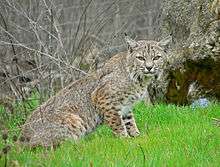 | |
| Bobcat in Livermore, California, US | |
| Scientific classification | |
| Kingdom: | Animalia |
| Phylum: | Chordata |
| Class: | Mammalia |
| Order: | Carnivora |
| Suborder: | Feliformia |
| Family: | Felidae |
| Subfamily: | Felinae |
| Genus: | Lynx |
| Species: | L. rufus |
| Binomial name | |
| Lynx rufus (Schreber, 1777) | |
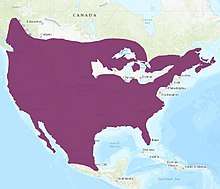 | |
| Distribution of Bobcat, 2016[1] | |
| Synonyms | |
| |
It has distinctive black bars on its forelegs and a black-tipped, stubby (or "bobbed") tail, from which it derives its name. It is smaller on average than the Canada lynx, with which it shares parts of its range, but is about twice as large as the domestic cat. It is an adaptable predator inhabiting wooded areas, as well as semidesert, urban edge, forest edge, and swampland environments. It remains in some of its original range, but populations are vulnerable to local extinction ("extirpation") by coyotes and domestic animals. Though the bobcat prefers rabbits and hares, it hunts insects, chickens, geese and other birds, small rodents, and deer. Prey selection depends on location and habitat, season, and abundance. Like most cats, the bobcat is territorial and largely solitary, although with some overlap in home ranges. It uses several methods to mark its territorial boundaries, including claw marks and deposits of urine or feces. The bobcat breeds from winter into spring and has a gestation period of about two months.
Two subspecies are recognised, one east of the Great Plains, and the other west of the Great Plains. They were probably separated during interglacial periods in the Pleistocene by the aridification of the Great Plains.[2] It first appeared during the Irvingtonian stage around 1.8 million years ago. The elusive predator features in some Indigenous Peoples' (of North and Central America) stories and in the folklore of European colonizers.
Taxonomy
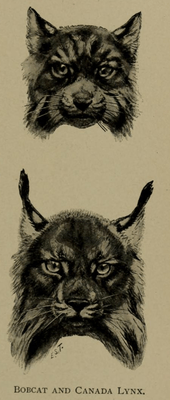
There had been debate over whether to classify this species as Lynx rufus or Felis rufus as part of a wider issue regarding whether the four species of Lynx should be given their own genus, or be placed as a subgenus of Felis.[3][4] The genus Lynx is now accepted, and the bobcat is listed as Lynx rufus in modern taxonomic sources.
Johnson et al. reported Lynx shared a clade with the puma, leopard cat (Prionailurus), and domestic cat (Felis) lineages, dated to 7.15 million years ago (mya); Lynx diverged first, approximately 3.24 million years ago.[5]
The bobcat is believed to have evolved from the Eurasian lynx, which crossed into North America by way of the Bering Land Bridge during the Pleistocene, with progenitors arriving as early as 2.6 million years ago.[4] The first wave moved into the southern portion of North America, which was soon cut off from the north by glaciers. This population evolved into modern bobcats around 20,000 years ago. A second population arrived from Asia and settled in the north, developing into the modern Canada lynx.[3] Hybridization between the bobcat and the Canada lynx may sometimes occur.[6]
Subspecies
13 bobcat subspecies have been historically recognized based on morphological characteristics:
- L. r. rufus (Schreber) – eastern and midwestern United States
- L. r. gigas (Bangs) – northern New York to Nova Scotia and New Brunswick
- L. r. floridanus (Rafinesque) – southeastern United States and inland to the Mississippi Valley, up to southwestern Missouri and southern Illinois
- L. r. superiorensis (Peterson & Downing) – western Great Lakes area, including upper Michigan, Wisconsin, southern Ontario, and most of Minnesota
- L. r. baileyi (Merriam) – southwestern United States and northwestern Mexico
- L. r. californicus (Mearns) – California west of the Sierra Nevada
- L. r. mohavensis (B.Anderson) – Mojave Desert of California
- L. r. escuinapae (J. A. Allen) – central Mexico, with a northern extension along the west coast to southern Sonora
- L. r. fasciatus (Rafinesque) – Oregon, Washington west of the Cascade Range, northwestern California, and southwestern British Columbia
- L. r. oaxacensis (Goodwin) – Oaxaca
- L. r. pallescens (Merriam) – northwestern United States and southern British Columbia, Alberta, and Saskatchewan
- L. r. peninsularis (Thomas) – Baja California
- L. r. texensis (Mearns) – western Louisiana, Texas, south-central Oklahoma, and south into Tamaulipas, Nuevo León, and Coahuila[7][8]
This subspecies division has been challenged, given a lack of clear geographic breaks in their ranges and the minor differences between these subspecies.[9] The latest revision of cat taxonomy in 2017, by the Cat Classification Taskforce of the Cat Specialist Group recognises only two subspecies, based on phylogeographic and genetic studies, although the status of the Mexican bobcat (Lynx rufus esquinapae syn. Lynx rufus oaxacensis) remains under review:[2][10]
- Lynx rufus rufus – east of the Great Plains, North America
- Lynx rufus fasciatus – west of the Great Plains, North America
Physical characteristics
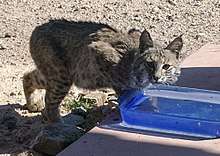
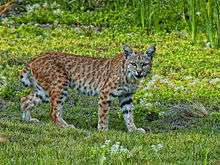
The bobcat resembles other species of the midsize genus Lynx, but is on average the smallest of the four. Its coat is variable, though generally tan to grayish-brown, with black streaks on the body and dark bars on the forelegs and tail. Its spotted patterning acts as camouflage. The ears are black-tipped and pointed, with short, black tufts. Generally, an off-white color is seen on the lips, chin, and underparts. Bobcats in the desert regions of the southwest have the lightest-colored coats, while those in the northern, forested regions are darkest. Kittens are born well-furred and already have their spots.[11] A few melanistic bobcats have been sighted and captured in Florida. They appear black, but may still exhibit a spot pattern.[12]
The face appears wide due to ruffs of extended hair beneath the ears. Bobcat eyes are yellow with round, black pupils. The nose of the bobcat is pinkish-red, and it has a base color of gray or yellowish- or brownish-red on its face, sides, and back.[13] The pupils are round, black circles and will widen during nocturnal activity to maximize light reception.[14] The cat has sharp hearing and vision, and a good sense of smell. It is an excellent climber, and swims when it needs to, but normally avoids water.[15] However, cases of bobcats swimming long distances across lakes have been recorded.[16]
The adult bobcat is 47.5 to 125 cm (18.7 to 49.2 in) long from the head to the base of its distinctive stubby tail, averaging 82.7 cm (32.6 in); the tail, which appears “bobbed” and gives the species its name,[17][18][19][20] adds 9 to 20 cm (3.5 to 7.9 in)[13]
An adult stands about 30 to 60 cm (12 to 24 in) at the shoulders.[11][21] Adult males can range in weight from 6.4 to 18.3 kg (14 to 40 lb), with an average of 9.6 kg (21 lb); females at 4 to 15.3 kg (8.8 to 33.7 lb), with an average of 6.8 kg (15 lb).[22][23] The largest bobcat accurately measured on record weighed 22.2 kg (49 lb), although unverified reports have them reaching 27 kg (60 lb).[24] Furthermore, a June 20, 2012 report of a New Hampshire roadkill specimen listed the animal's weight at 27 kg (60 lb).[25] The largest-bodied bobcats are from eastern Canada and northern New England of the subspecies L. r. gigas, while the smallest are from the southeastern subspecies L. r. floridanus, particularly those in the southern Appalachians.[26] The bobcat is muscular, and its hind legs are longer than its front legs, giving it a somewhat irregular gait. At birth, it weighs 0.6 to 0.75 lb (270 to 340 g) and is about 10 in (25 cm) in length. By its first birthday, it weighs about 10 lb (4.5 kg).[15]
The cat is larger in its northern range and in open habitats.[27] A morphological size comparison study in the eastern United States found a divergence in the location of the largest male and female specimens, suggesting differing selection constraints for the sexes.[28]
Behavior
The bobcat is crepuscular, and is active mostly during twilight. It keeps on the move from three hours before sunset until about midnight, and then again from before dawn until three hours after sunrise. Each night, it moves from 2 to 7 mi (3.2 to 11.3 km) along its habitual route.[15] This behavior may vary seasonally, as bobcats become more diurnal during fall and winter in response to the activity of their prey, which are more active during the day in colder weather.[14]
Social structure and home range

Bobcat activities are confined to well-defined territories, which vary in size depending on the sex and the distribution of prey. The home range is marked with feces, urine scent, and by clawing prominent trees in the area.[29] In its territory, the bobcat has numerous places of shelter, usually a main den, and several auxiliary shelters on the outer extent of its range, such as hollow logs, brush piles, thickets, or under rock ledges. Its den smells strongly of the bobcat.[30]
The sizes of bobcats' home ranges vary significantly; a World Conservation Union (IUCN) summary of research suggests ranges from 0.23 to 126 sq mi (0.60 to 326.34 km2).[27] One study in Kansas found resident males to have ranges of roughly 8 sq mi (21 km2), and females less than half that area. Transient bobcats were found to have both larger (roughly 22 sq mi (57 km2)) and less well-defined home ranges. Kittens had the smallest range at about 3 sq mi (7.8 km2).[31] Dispersal from the natal range is most pronounced with males.[32]
Reports on seasonal variation in range size have been equivocal. One study found a large variation in male range sizes, from 16 sq mi (41 km2) in summer up to 40 sq mi (100 km2) in winter.[30] Another found that female bobcats, especially those which were reproductively active, expanded their home range in winter, but that males merely shifted their range without expanding it, which was consistent with numerous earlier studies.[33] Other research in various American states has shown little or no seasonal variation.[31][34][35]
Like most felines, the bobcat is largely solitary, but ranges often overlap. Unusual for cats, males are more tolerant of overlap, while females rarely wander into others' ranges.[33] Given their smaller range sizes, two or more females may reside within a male's home range. When multiple territories overlap, a dominance hierarchy is often established, resulting in the exclusion of some transients from favored areas.[30]
In line with widely differing estimates of home range size, population density figures are divergent, from one to 38 bobcats per 10 sq mi (26 km2) in one survey.[27] The average is estimated at one bobcat per 5 square miles (13 km2).[30] A link has been observed between population density and sex ratio. One study noted a dense, unhunted population in California had a sex ratio of 2.1 males per female. When the density decreased, the sex ratio skewed to 0.86 males per female. Another study observed a similar ratio, and suggested the males may be better able to cope with the increased competition, and this helped limit reproduction until various factors lowered the density.[36]
Hunting and diet
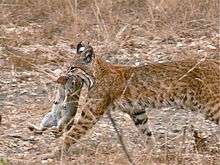
The bobcat is able to survive for long periods without food, but eats heavily when prey is abundant. During lean periods, it often preys on larger animals, which it can kill and return to feed on later. The bobcat hunts by stalking its prey and then ambushing with a short chase or pounce. Its preference is for mammals weighing about 1.5 to 12.5 lb (0.68 to 5.67 kg). Its main prey varies by region. In the eastern United States, it is the eastern cottontail species, and in the north it is the snowshoe hare. When these prey species exist together, as in New England, they are the primary food sources of the bobcat. In the far south, the rabbits and hares are sometimes replaced by cotton rats as the primary food source. Birds up to the size of an adult swan are also taken in ambushes, along with their fledglings and eggs.[37] The bobcat is an opportunistic predator that, unlike the more specialized Canada lynx, readily varies its prey selection.[27] Diet diversification positively correlates to a decline in numbers of the bobcat's principal prey; the abundance of its main prey species is the main determinant of overall diet.[38]
The bobcat hunts animals of different sizes, and adjusts its hunting techniques accordingly. With small animals, such as rodents (including squirrels), birds, fish including small sharks,[39] and insects, it hunts in areas known to be abundant in prey, and will lie, crouch, or stand, and wait for victims to wander close. It then pounces, grabbing its prey with its sharp, retractable claws. For slightly larger animals, such as geese, rabbits, and hares, it stalks from cover and waits until prey comes within 20 to 35 ft (6.1 to 10.7 m) before rushing in to attack. Less commonly, it feeds on larger animals, such as young ungulates, and other carnivores, such as fishers (primarily female), foxes, minks, martens, skunks, small dogs, and domesticated cats.[30][40][41][42][43] Bobcats are considered the major predatory threat to the endangered whooping crane.[44] Bobcats are also occasional hunters of livestock and poultry. While larger species, such as cattle and horses, are not known to be attacked, bobcats do present a threat to smaller ruminants, such as sheep and goats. According to the National Agricultural Statistics Service, bobcats killed 11,100 sheep in 2004, comprising 4.9% of all sheep predator deaths.[45] However, some amount of bobcat predation may be misidentified, as bobcats have been known to scavenge on the remains of livestock kills by other animals.[46]
It has been known to kill deer, especially in winter when smaller prey is scarce, or when deer populations become more abundant. One study in the Everglades showed a large majority of kills (33 of 39) were fawns, but prey up to eight times the bobcat's weight could be successfully taken.[47] It stalks the deer, often when the deer is lying down, then rushes in and grabs it by the neck before biting the throat, base of the skull, or chest. On the rare occasions a bobcat kills a deer, it eats its fill and then buries the carcass under snow or leaves, often returning to it several times to feed.[30]
The bobcat prey base overlaps with that of other midsized predators of a similar ecological niche. Research in Maine has shown little evidence of competitive relationships between the bobcat and coyote or red fox; separation distances and territory overlap appeared random among simultaneously monitored animals.[48] However, other studies have found bobcat populations may decrease in areas with high coyote populations, with the more social inclination of the canid giving them a possible competitive advantage.[49] With the Canada lynx, however, the interspecific relationship affects distribution patterns; competitive exclusion by the bobcat is likely to have prevented any further southward expansion of the range of its felid relative.[4]
Reproduction and life cycle

The average bobcat lifespan is 7 years long and rarely exceeds 10 years. The oldest wild bobcat on record was 16 years old, and the oldest captive bobcat lived to be 32.[36]
Bobcats generally begin breeding by their second summer, though females may start as early as their first year. Sperm production begins each year by September or October, and the male is fertile into the summer. A dominant male travels with a female and mates with her several times, generally from winter until early spring; this varies by location, but most mating takes place during February and March. The pair may undertake a number of different behaviors, including bumping, chasing, and ambushing. Other males may be in attendance, but remain uninvolved. Once the male recognizes the female is receptive, he grasps her in the typical felid neck grip and mates with her. The female may later go on to mate with other males,[30] and males generally mate with several females.[50] During courtship, the otherwise silent bobcat may let out loud screams, hisses, or other sounds.[51] Research in Texas has suggested establishing a home range is necessary for breeding; studied animals with no set range had no identified offspring.[32] The female has an estrous cycle of 44 days, with the estrus lasting five to ten days. Bobcats remain reproductively active throughout their lives.[14][50]
The female raises the young alone. One to six, but usually two to four, kittens are born in April or May, after roughly 60 to 70 days of gestation. Sometimes, a second litter is born as late as September. The female generally gives birth in an enclosed space, usually a small cave or hollow log. The young open their eyes by the ninth or tenth day. They start exploring their surroundings at four weeks and are weaned at about two months. Within three to five months, they begin to travel with their mother.[51] They hunt by themselves by fall of their first year, and usually disperse shortly thereafter.[30] In Michigan, however, they have been observed staying with their mother as late as the next spring.[50]
Tracks
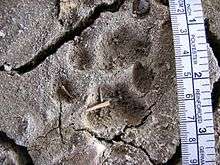
Bobcat tracks show four toes without claw marks, due to their retractable claws. The tracks can range in size from 1 to 3 in (2.5 to 7.6 cm); the average is about 1.8 inches.[52] When walking or trotting, the tracks are spaced roughly 8 to 18 in (20 to 46 cm) apart. The bobcat can make great strides when running, often from 4 to 8 ft (1.2 to 2.4 m).[53]
Like all cats, the bobcat 'directly registers', meaning its hind prints usually fall exactly on top of its fore prints. Bobcat tracks can be generally distinguished from feral or house cat tracks by their larger size: about 2.0 in2 (13 cm²) versus 1.5 in2 (10 cm²).[54]
Ecology

The adult bobcat has relatively few predators other than humans. However seldomly, it may be killed in interspecific conflict by several larger predators or fall prey to them. Cougars and gray wolves can kill adult bobcats, a behavior repeatedly observed in Yellowstone National Park as well as elsewhere.[55][56] Coyotes have killed adult bobcats and kittens.[57][58][59] At least one confirmed observation of a bobcat and an American black bear (Ursus americanus) fighting over a carcass is confirmed.[60] Like other Lynx species, bobcats probably avoid encounters with bears, in part because they are likely to lose kills to them or may be rarely be attacked by them.[61][62] Bobcat remains have occasionally been found in the resting sites of male fishers.[63] American alligators (Alligator mississippensis) have been filmed opportunistically preying on adult bobcats in the southeast United States.[64][65]

Kittens may be taken by several predators, including owls (almost entirely great horned owls), eagles, foxes, and bears, as well as other adult male bobcats;[66] when prey populations are not abundant, fewer kittens are likely to reach adulthood. Golden eagles (Aquila chrysaetos) have been reportedly observed preying on bobcats.[67]
Diseases, accidents, hunters, automobiles, and starvation are the other leading causes of death. Juveniles show high mortality shortly after leaving their mothers, while still perfecting their hunting techniques. One study of 15 bobcats showed yearly survival rates for both sexes averaged 0.62, in line with other research suggesting rates of 0.56 to 0.67.[68] Cannibalism has been reported; kittens may be taken when prey levels are low, but this is very rare and does not much influence the population.[36]
The bobcat may have external parasites, mostly ticks and fleas, and often carries the parasites of its prey, especially those of rabbits and squirrels. Internal parasites (endoparasites) are especially common in bobcats.[69] One study found an average infection rate of 52% from Toxoplasma gondii, but with great regional variation.[70] One mite in particular, Lynxacarus morlani, has to date been found only on the bobcat. Parasites' and diseases' role in the mortality of the bobcat is still unclear, but they may account for greater mortality than starvation, accidents, and predation.[36]
Distribution and habitat
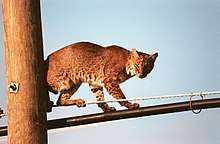
The bobcat is an adaptable animal. It prefers woodlands—deciduous, coniferous, or mixed—but unlike the other Lynx species, it does not depend exclusively on the deep forest. It ranges from the humid swamps of Florida to desert lands of Texas or rugged mountain areas. It makes its home near agricultural areas, if rocky ledges, swamps, or forested tracts are present; its spotted coat serves as camouflage.[30] The population of the bobcat depends primarily on the population of its prey; other principal factors in the selection of habitat type include protection from severe weather, availability of resting and den sites, dense cover for hunting and escape, and freedom from disturbance.[9]
The bobcat's range does not seem to be limited by human populations, as long as it can find a suitable habitat; only large, intensively cultivated tracts are unsuitable for the species.[27] The animal may appear in back yards in "urban edge" environments, where human development intersects with natural habitats.[71] If chased by a dog, it usually climbs up a tree.[30]
The historical range of the bobcat was from southern Canada, throughout the United States, and as far south as the Mexican state of Oaxaca, and it still persists across much of this area. In the 20th century, it was thought to have lost territory in the US Midwest and parts of the Northeast, including southern Minnesota, eastern South Dakota, and much of Missouri, mostly due to habitat changes from modern agricultural practices.[14][27][30] While thought to no longer exist in western New York and Pennsylvania, multiple confirmed sightings of bobcats (including dead specimens) have been recently reported in New York's Southern Tier and in central New York, and a bobcat was captured in 2018 on a tourist boat in Downtown Pittsburgh, Pennsylvania.[72][73] In addition, bobcat sightings have been confirmed in northern Indiana, and one was recently killed near Albion, Michigan.[74] In early March 2010, a bobcat was sighted (and later captured by animal control authorities) in a parking garage in downtown Houston.[75] By 2010, bobcats appear to have recolonized many states, occurring in every state except Delaware.[1]
Its population in Canada is limited due to both snow depth and the presence of the Canadian lynx. The bobcat does not tolerate deep snow, and waits out heavy storms in sheltered areas;[76] it lacks the large, padded feet of the Canadian lynx and cannot support its weight on snow as efficiently. The bobcat is not entirely at a disadvantage where its range meets that of the larger felid: displacement of the Canadian lynx by the aggressive bobcat has been observed where they interact in Nova Scotia, while the clearing of coniferous forests for agriculture has led to a northward retreat of the Canadian lynx's range to the advantage of the bobcat.[27] In northern and central Mexico, the cat is found in dry scrubland and forests of pine and oak; its range ends at the tropical southern portion of the country.[27]
Conservation
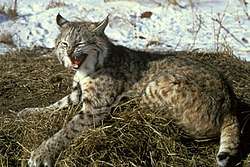
It is listed in Appendix II of the Convention on International Trade in Endangered Species of Wild Fauna and Flora (CITES),[77] which means it is not considered threatened with extinction, but hunting and trading must be closely monitored. The animal is regulated in all three of its range countries, and is found in a number of protected areas of the United States, its principal territory.[27] Estimates from the US Fish and Wildlife Service placed bobcat numbers between 700,000 and 1,500,000 in the US in 1988, with increased range and population density suggesting even greater numbers in subsequent years; for these reasons, the U.S. has petitioned CITES to remove the cat from Appendix II.[9] Populations in Canada and Mexico remain stable and healthy. It is listed as least concern on the IUCN Red List, noting it is relatively widespread and abundant, but information from southern Mexico is poor.[1]
The species is considered endangered in Ohio, Indiana, and New Jersey. It was removed from the threatened list of Illinois in 1999 and of Iowa in 2003. In Pennsylvania, limited hunting and trapping are once again allowed, after having been banned from 1970 to 1999. The bobcat also suffered population decline in New Jersey at the turn of the 19th century, mainly because of commercial and agricultural developments causing habitat fragmentation; by 1972, the bobcat was given full legal protection, and was listed as endangered in the state in 1991.[14] L. r. escuinipae, the subspecies found in Mexico, was for a time considered endangered by the US Fish and Wildlife Service, but was delisted in 2005.[78]
The bobcat has long been valued both for fur and sport; it has been hunted and trapped by humans, but has maintained a high population, even in the southern United States, where it is extensively hunted. In the 1970s and 1980s, an unprecedented rise in price for bobcat fur caused further interest in hunting, but by the early 1990s, prices had dropped significantly.[79] Regulated hunting still continues, with half of mortality of some populations being attributed to this cause. As a result, the rate of bobcat deaths is skewed in winter, when hunting season is generally open.[36]
Urbanization can result in the fragmentation of contiguous natural landscapes into patchy habitat within an urban area. Animals that live in these fragmented areas often have reduced movement between the habitat patches, which can lead to reduced gene flow and pathogen transmission between patches. Animals such as the bobcat are particularly sensitive to fragmentation because of their large home ranges.[80] A study in coastal Southern California has shown bobcat populations are affected by urbanization, creation of roads, and other developments. The populations may not be declining as much as predicted, but instead the connectivity of different populations is affected. This leads to a decrease in natural genetic diversity among bobcat populations.[81] For bobcats, preserving open space in sufficient quantities and quality is necessary for population viability. Educating local residents about the animals is critical, as well, for conservation in urban areas.[82]
In bobcats using urban habitats in California, the use of rodenticides has been linked to both secondary poisoning by consuming poisoned rats and mice, and to increased rates of severe mite infestation (known as notoedric mange), as an animal with a poison-weakened immune system is less capable of fighting off mange. Liver autopsies in California bobcats that have succumbed to notoedric mange have revealed chronic rodenticide exposure.[83][84] Alternative rodent control measures such as vegetation control and use of traps have been suggested to alleviate this issue.[85]
Importance in human culture
Stories featuring the bobcat, in many variations, are found in some Indigenous cultures of North America, with parallels in South America. A story from the Nez Perce, for instance, depicts lynx and coyote as opposed, antithetical beings.[86] However, another version depicts them with equality and identicality.
In a Shawnee tale, the bobcat is outwitted by a rabbit, which gives rise to its spots. After trapping the rabbit in a tree, the bobcat is persuaded to build a fire, only to have the embers scattered on its fur, leaving it singed with dark brown spots.[87] The Mohave believed dreaming habitually of beings or objects would afford them their characteristics as supernatural powers. Dreaming of two deities, cougar and lynx, they thought, would grant them the superior hunting skills of other Tribes.[88] European colonizers to the Americas also admired the cat, both for its ferocity and its grace, and in the United States, it "rests prominently in the anthology of ... national folklore."[89]
Grave artifacts from dirt domes excavated in the 1980s along the Illinois River revealed a complete skeleton of a young bobcat along with a collar made of bone pendants and shell beads that had been buried by the Hopewell culture. The type and place of burial indicate a tamed and cherished pet or possible spiritual significance. The Hopewell normally buried their dogs, so the bones were initially identified as remains of a puppy, but dogs were usually buried close to the village and not in the mounds themselves. This is the only wild cat decorated burial on the archaeological record.[90][91]
See also
References
- Kelly, M.; Morin, D. & Lopez-Gonzalez, C. A. (2016). "Lynx rufus". IUCN Red List of Threatened Species. 2016: e.T12521A50655874.
- Kitchener, A. C.; Breitenmoser-Würsten, C.; Eizirik, E.; Gentry, A.; Werdelin, L.; Wilting, A.; Yamaguchi, N.; Abramov, A. V.; Christiansen, P.; Driscoll, C.; Duckworth, J. W.; Johnson, W.; Luo, S.-J.; Meijaard, E.; O'Donoghue, P.; Sanderson, J.; Seymour, K.; Bruford, M.; Groves, C.; Hoffmann, M.; Nowell, K.; Timmons, Z.; Tobe, S. (2017). "A revised taxonomy of the Felidae: The final report of the Cat Classification Task Force of the IUCN Cat Specialist Group" (PDF). Cat News (Special Issue 11): 38–40.
- Zielinski, William J; Kuceradate, Thomas E (1998). American Marten, Fisher, Lynx, and Wolverine: Survey Methods for Their Detection. DIANE Publishing. pp. 77–8. ISBN 978-0-7881-3628-3.
- Carron Meaney; Gary P. Beauvais (September 2004). "Species Assessment for Canada lynx (Lynx Canadensis) in Wyoming" (PDF). United States Department of the Interior, Bureau of Land Management. Retrieved June 25, 2007.
- Johnson, W.E.; Eizirik, E.; Pecon-Slattery, J.; Murphy, W.J.; Antunes, A.; Teeling, E. & O'Brien, S.J. (2006). "The Late Miocene radiation of modern Felidae: A genetic assessment". Science. 311 (5757): 73–77. Bibcode:2006Sci...311...73J. doi:10.1126/science.1122277. PMID 16400146.
- Mills, L. Scott (November 2006). Conservation of Wildlife Populations: Demography, Genetics, and Management. Blackwell Publishing. p. 48. ISBN 978-1-4051-2146-0.
- Wozencraft, W.C. (2005). "Order Carnivora". In Wilson, D.E.; Reeder, D.M (eds.). Mammal Species of the World: A Taxonomic and Geographic Reference (3rd ed.). Johns Hopkins University Press. p. 542. ISBN 978-0-8018-8221-0. OCLC 62265494.
- Wilson, Don E; Ruff, Sue (September 1999). The Smithsonian Book of North American Mammals. Smithsonian Institution Press. pp. 234–5. ISBN 978-1-56098-845-8.
- "Deletion of Bobcat (Lynx rufus) from Appendix II" (PDF). Thirteenth Meeting of the Conference of the Parties, Proposal 5. Convention on International Trade in Endangered Species of Wild Fauna and Flora. October 2004. Archived from the original (PDF) on November 2, 2013. Retrieved May 31, 2007.
- "Bobcat". IUCN Specialist Cat Group. Retrieved June 2, 2017.
- Cahalane, Victor H (March 1, 2005). Meeting the Mammals. Kessinger Publishing. p. 64. ISBN 978-1-4179-9522-6.
- Ulmer Jr., Fred A. (1941). "Melanism in the Felidae, with Special Reference to the Genus Lynx". Journal of Mammalogy. 22 (3): 285–288. doi:10.2307/1374954. JSTOR 1374954.
- Sparano, Vin T (September 1998). Complete Outdoors Encyclopedia. St. Martin's Press. p. 228. ISBN 978-0-312-19190-0.
- McDowell, Robert L (April 2003). Endangered and Threatened Wildlife of New Jersey. Rutgers University Press. pp. 23–4, 27. ISBN 978-0-8135-3209-7.
- Fergus, Charles (August 1, 2003). Wildlife of Virginia and Maryland Washington D.C. Stackpole Books. p. 119. ISBN 978-0-8117-2821-8.
- Bobcat Swims Across Lake Lanier. Youtube (August 3, 2015)
- "Great Cats: Bobcats – National Zoo| FONZ". Nationalzoo.si.edu. Archived from the original on April 1, 2012. Retrieved October 17, 2011.
- "Bobcats, Bobcat Pictures, Bobcat Facts – National Geographic". Animals.nationalgeographic.com. Retrieved October 17, 2011.
- "FieldGuides: Species Detail". eNature. Archived from the original on March 19, 2012. Retrieved October 17, 2011.
- "bobcat (mammal)". Encyclopaedia Britannica Online. Retrieved October 17, 2011.
- "Bobcat – Profile of the Bobcat". Animals.about.com. March 3, 2009. Retrieved October 17, 2011.
- "Picture of a Bobcat". Pictures-of-cats.org. Retrieved February 21, 2011.
- Burnie D and Wilson DE (Eds.), Animal: The Definitive Visual Guide to the World's Wildlife. DK Adult (2005), ISBN 0-7894-7764-5
- Chiamulera, Joshua; Krueger, Eric; Yarbrough, Chris. "Bobcat Lynx rufus". Uwsp.edu. Archived from the original on June 8, 2011. Retrieved February 21, 2011.
- Schreiber, Jason (June 20, 2012). 60-pound bobcat turns up as roadkill Archived June 25, 2012, at the Wayback Machine . Union Leader
- "Bobcat Profile- The American Society of Mammalogists" (PDF). smith.edu. Retrieved September 23, 2011.
- Nowell, K. and Jackson, P. (1996). Wild Cats. Status Survey and Conservation Action Plan. (PDF). IUCN/SSC Cat Specialist Group. IUCN, Gland, Switzerland.
- Sikes, Robert S.; Michael L. Kennedy (1992). "Morphologic Variation of the Bobcat (Felis rufus) in the Eastern United States and Its Association with Selected Environmental Variables". American Midland Naturalist. 128 (2): 313–324. doi:10.2307/2426465. JSTOR 2426465.
- Allen, Maximilian L., Cody F. Wallace, and Christopher C. Wilmers. "Patterns in bobcat (Lynx rufus) scent marking and communication behaviors." Journal of ethology 33.1 (2015): 9-14.
- Whitaker, John O; Hamilton, W J (January 1, 1998). Mammals of the Eastern United States. Cornell University Press. pp. 493–6. ISBN 978-0-8014-3475-4.
- Kamler, Jan F.; Gipson, Philip S. (July–September 2000). "Home range, habitat selection, and survival of bobcats, Lynx rufus, in a prairie ecosystem in Kansas". Canadian Field-Naturalist. 114 (3): 388–94.
- Janečka, JE; TL Blankenship; DH Hirth; ME Tewes; CW Kilpatrick; LI Grassman Jr. (August 2006). "Kinship and social structure of Bobcats (Lynx rufus) inferred from microsatellite and radio-telemetry data". Journal of Zoology. 269 (4): 494–501. doi:10.1111/j.1469-7998.2006.00099.x.
- Lovallo, Matthew J.; Anderson, Eric M. (April 1996). "Bobcat (Lynx rufus) Home Range Size and Habitat Use in Northwest Wisconsin". American Midland Naturalist. 135 (2): 247–8. doi:10.2307/2426706. JSTOR 2426706.
- Nielsen, Clayton K.; Alan Woolf (July 2001). "Spatial Organization of Bobcats (Lynx rufus) in Southern Illinois". The American Midland Naturalist. 146 (1): 43–52. doi:10.1674/0003-0031(2001)146[0043:SOOBLR]2.0.CO;2.
- Chamberlain, Michael I.; Bruce D. Leopold; L. Mike Conner (2003). "Space use, movements and habitat selection of adult Bobcats (Lynx rufus) in Central Mississippi". The American Midland Naturalist. 149 (2): 395–405. doi:10.1674/0003-0031(2003)149[0395:SUMAHS]2.0.CO;2.
- Feldhamer, George A; Thompson, Bruce C; Chapman, Joseph A (January 1, 2004). Wild Mammals of North America. Johns Hopkins University Press. pp. 769–70. ISBN 978-0-8018-7416-1.
- Smith, J. W. (1988). Status of Missouri's experimental Trumpeter Swan restoration program. In Proc. and Papers of the 10th Trumpeter Swan Society Conf., edited by D. Compton, 100–103. Maple Plain, MN: The Trumpeter Swan Society.
- Baker, Leslie A.; Warren, Robert J.; Diefenbach, Duane R.; James, William E.; Conroy, Michael J. (2001). "Prey Selection by Reintroduced Bobcats (Lynx rufus) on Cumberland Island, Georgia". The American Midland Naturalist. 145 (1): 80–93. doi:10.1674/0003-0031(2001)145[0080:PSBRBL]2.0.CO;2.
- Bobcat Drags Shark Out of Florida Surf
- "Fewer Fishers in the Forest". Minnesota Conservation Volunteer Magazine. Minnesota Department of Natural Resources. Archived from the original on July 6, 2014. Retrieved June 5, 2013.
- Sweitzer, Rick A.; Barrett, Reginald H. (July 22, 2010). "SNAMP Fisher Study: Sources" (PDF). Sierra Nevada Adaptive Management Project. Retrieved June 5, 2013.
- Donadio, E., & Buskirk, S. W. (2006). Diet, morphology, and interspecific killing in Carnivora. The American Naturalist, 167(4), 524-536.
- Farias, V., Fuller, T. K., Wayne, R. K., & Sauvajot, R. M. (2005). Survival and cause-specific mortality of gray foxes (Urocyon cinereoargenteus) in southern California. Journal of Zoology, 266(3), 249-254.
- "Whooping Crane Flock Status". Whoopingcrane.com. Archived from the original on June 30, 2009. Retrieved February 21, 2011.
- Sheep and Goats Death Loss. National Agricultural Statistics Service. May 6, 2005. Retrieved December 27, 2007.
- Neale, Jennifer C. C.; Sacks, Benjamin N.; Jaeger, Michael M.; McCullough, Dale R. (April 1998). "A Comparison of Bobcat and Coyote Predation on Lambs in North-Coastal California". The Journal of Wildlife Management. 62 (2): 700–706. doi:10.2307/3802346. JSTOR 3802346. S2CID 31260042.
The proportion of Bobcat scats containing sheep consumed by Bobcats was small (4.2%) and occurrence did not peak in the lambing season, suggesting that sheep consumed by bobcats were scavenged
- Labisky, Ronald F.; Margaret C. Boulay (April 1998). "Behaviors of Bobcats Preying on White-tailed Deer in the Everglades". The American Midland Naturalist. 139 (2): 275–281. doi:10.1674/0003-0031(1998)139[0275:BOBPOW]2.0.CO;2.
- Major, JT; JA Sherburne (1987). "Interspecific relationships of Coyotes, Bobcats, and Red Foxes in western Maine". Journal of Wildlife Management. 51 (3): 606–616. doi:10.2307/3801278. JSTOR 3801278.
- Litvaitis, J. A. & D. J. Harrison (1989). "Bobcat-coyote niche relationships during a period of coyote population increase". Canadian Journal of Zoology. 67 (5): 1180–1188. doi:10.1139/z89-170.
- Fischer, William C.; Miller, Melanie; Johnston, Cameron M.; Smith, Jane K. (February 1, 1996). Fire Effects Information System. DIANE Publishing. p. 83. ISBN 978-0-7881-4568-1.
- Nowak, Ronald M (April 1999). Walker's Mammals of the World. Johns Hopkins University Press. p. 809. ISBN 978-0-8018-5789-8.
- "Bobcat". bcadventure.com. Interactive Broadcasting Corporation. Archived from the original on July 12, 2007. Retrieved June 25, 2007.
- Peterson, Roger Tory; Murie, Olaus Johan (January 15, 1998). A Field Guide to Animal Tracks. Houghton Mifflin Field Guides. p. 115. ISBN 978-0-395-91094-8.
- Brown, Tom (1986). Tom Brown's Field Guide to Nature Observation and Tracking. Berkley Trade. ISBN 978-0-425-09966-7.
- Holly Akenson; James Akenson; Howard Quigley. "Winter Predation and Interactions of Wolves and Cougars on Panther Creek in Central Idaho". Wildlife: Wolves. Yellowstone National Park. Retrieved June 24, 2007.
- Palomares, F., & Caro, T. M. (1999). Interspecific killing among mammalian carnivores. The American Naturalist, 153(5), 492-508.
- Fedriani, J. M.; Fuller, T. K.; Sauvajot R. M. & York, E. C. (2000). "Competition and intraguild predation among three sympatric carnivores". Oecologia. 125 (2): 258–270. Bibcode:2000Oecol.125..258F. doi:10.1007/s004420000448. hdl:10261/54628. PMID 24595837.
- Gipson, P. S. & Kamler, J. F (2002). "Bobcat killed by coyote". Southwestern Naturalist. 47 (3): 511–514. doi:10.2307/3672519. JSTOR 3672519.
- Knick, S. T. (1990). "Ecology of bobcats relative to exploitation and a prey decline in southeastern Idaho". Wildlife Monographs. 108 (108): 1–42. JSTOR 3830671.
- "Bobcat vs Bear: Competition over deer carcass". Hunting Washington Forum. Retrieved November 1, 2008.
- Krofel, M., Kos, I., & Jerina, K. (2012). The noble cats and the big bad scavengers: effects of dominant scavengers on solitary predators. Behavioral Ecology and Sociobiology, 66(9), 1297-1304.
- IUCN/SSC Cat Specialist Group, Kristin Nowell, Peter Jackson. (1996). Wild Cats: Status survey and conservation action plan. Cambridge, UK: IUCN Publication Services Unit. ISBN 2-8317-0045-0
- Aubry, Keith and Rale, Catherine (July 2006) Ecological Characteristics of Fishers (Martes pennanti) in the Southern Oregon Cascade Range. USDA Forest Service—Pacific Northwest Research Station, Olympia Forestry Sciences Laboratory, Olympia, WA, U.S.
- "Gator eats bobcat". Flickr. November 7, 2012. Retrieved November 7, 2012.
- "Sneaky alligator nearly eats bobcat". Kens5. Archived from the original on January 11, 2014. Retrieved June 1, 2012.
- "Bobcats". Living with Wildlife. Washington Department of Fish and Wildlife. Retrieved August 23, 2016.
- "Golden Eagle, Life History, All About Birds - Cornell Lab of Ornithology". Cornell Lab of Ornithology.
- Fuller, Todd K.; Stephen L. Berendzen; Thomas A. Decker; James E. Cardoza (October 1995). "Survival and Cause-Specific Mortality Rates of Adult Bobcats (Lynx rufus)". American Midland Naturalist. 134 (2): 404–408. doi:10.2307/2426311. JSTOR 2426311.
- Hiestand, SJ.; Nielsen, CK.; Jiménez, FA. (2014). "Epizootic and zoonotic helminths of the bobcat (Lynx rufus) in Illinois and a comparison of its helminth component communities across the American Midwest". Parasite. 21: 4. doi:10.1051/parasite/2014005. PMC 3923260. PMID 24521984.

- Kikuchi, Yoko; Chomel, Bruno B; Kasten, Rickie W; Martenson, Janice S; Swift, Pamela K; O'Brien, Stephen J (2004). "Seroprevalence of Toxoplasma gondii in American free-ranging or captive pumas (Felis concolor) and Bobcats (Lynx rufus)". Veterinary Parasitology. 120 (1–2): 1–9. doi:10.1016/j.vetpar.2004.01.002. PMID 15019138.
- "Bobcats: Living on the Urban Edge". National Park Service, U.S. Department of the Interior. Retrieved June 18, 2007.
- Tobin, Dave (May 31, 2007). "Elusive Bobcat Creeps into Region". Syracuse Post-Standard. Retrieved June 26, 2007.
- Allen, Bob (March 18, 2018). "Bobcat Found On Gateway Clipper Boat Removed By Animal Control". Pittsburgh Post-Gazette. Retrieved March 19, 2018.
- "Bobcat killed near Albion". MLive.com. Jackson Citizen Patriot. October 25, 2008. Retrieved February 15, 2009.
- "Bobcat captured in Houston parking garage". Houston Chronicle. chron.com. March 2, 2010. Retrieved March 3, 2010.
- National Park Service. Yellowstone National Park. "Bobcat". Archived from the original on May 23, 2006. Retrieved August 24, 2006.
- "Appendices I, II and III". Convention on International Trade in Endangered Species of Wild Fauna and Flora. Archived from the original on May 19, 2007. Retrieved May 24, 2007.
- "Endangered and Threatened Wildlife and Plants; 12-Month Petition Finding and Proposed Rule To Delist the Mexican Bobcat (Lynx rufus escuinapae)". Fish and Wildlife Service. May 2005. Retrieved June 27, 2007.
- Grenfell Jr., William E. (November 1996). Bobcat Harvest Assessment 1995–96 (Report). California Department of Fish and Game.
- Lee, J. S.; Ruell, E. W.; Boydston, E. E.; Lyren, L. M.; Alonso, R. S.; Troyer, J. L.; Crooks, K. R.; Vandewoude, S. U. E. (2012). "Gene flow and pathogen transmission among bobcats (Lynx rufus) in a fragmented urban landscape". Molecular Ecology. 21 (7): 1617–1631. doi:10.1111/j.1365-294X.2012.05493.x. PMID 22335296.
- Ruell, E.W.; Riley, S.P.D.; Douglas, M.R.; Antolin, M.F.; Pollinger, J.R.; Tracey, J.A.; Lyren, L.M.; Boydston, E.E.; Fisher, R.N.; Crooks, K.R. (2012). "Urban Habitat Fragmentation and Genetic Population Structure of Bobcats in Coastal Southern California". The American Midland Naturalist. 168 (2): 265–280. doi:10.1674/0003-0031-168.2.265.
- Riley, Seth P. D.; Sauvajot, Raymond M.; Fuller, Todd K.; York, Eric C.; Kamradt, Denise A.; Bromley, Cassity; Wayne, Robert K. (2003). "Effects of Urbanization and Habitat Fragmentation on Bobcats and Coyotes in Southern California". Conservation Biology. 17 (2): 566–576. doi:10.1046/j.1523-1739.2003.01458.x. S2CID 85375755.
- "Notoedric Mange: A Sentinel for a Big Problem in our Local Ecosystems?". Urban Carnivores. 2011.
- Riley, S.P.D.; Bromley, C.; Poppenga, R.H.; Whited, L.; Sauvajot, R.M. (2007). "Anticoagulant exposure and notoedric mange in bobcats and mountain lions in urban Southern California". Journal of Wildlife Management. 71 (6): 1874–1884. doi:10.2193/2005-615.
- "Rodenticide: Impacts and Alternatives". Urban Wildlife Research Project. October 11, 2015. Retrieved August 5, 2016.
- Pollock, Donald (March 1993). "Histoire de Lynx, Review". American Anthropologist. 95 (1): 223–224. doi:10.1525/aa.1993.95.1.02a00800.
- "Florida Bobcat Bio Facts". Jacksonville Zoo and Gardens. 2005. Archived from the original on February 25, 2006. Retrieved June 27, 2007.
- Kroeber, A. L. (April–June 1908). "Preliminary Sketch of the Mohave Indians". American Anthropologist. 4 (2): 276–285. doi:10.1525/aa.1902.4.2.02a00060.
- Temple, Kerry (Spring 1996). "Wood Ghost". Notre Dame Magazine. Archived from the original on December 19, 2006. Retrieved June 25, 2007.
- Perri, Angela R.; Martin, Terrance J.; Farnsworth, Kenneth B. (2015). "A Bobcat Burial and Other Reported Intentional Animal Burials from Illinois Hopewell Mounds". Midcontinental Journal of Archaeology. 40 (3): 282. doi:10.1179/2327427115Y.0000000007.
- Grimm, David (2015). "Ancient bobcat buried like a human being". Science. doi:10.1126/science.aac8794.
Further reading
- Burton, Maurice; Robert Burton (1970). The international wildlife encyclopedia. Volume 1. Marshall Cavendish Corp. pp. 253–257. ISBN 978-0-7614-7266-7.
- Hansen, Kevin (2006). Bobcat: master of survival. Oxford University Press. ISBN 978-0-19-518303-0.
- Sunquist, Melvin E; Fiona Sunquist (2002). Wild cats of the world. University of Chicago Press. pp. 185–197. ISBN 978-0-226-77999-7.
- Van Wormer, Joe (1963). The World of the Bobcat. J. B. Lippincott. OCLC 684572.
External links
| Wikispecies has information related to Lynx rufus |
| Wikimedia Commons has media related to Lynx rufus. |
- Species portrait Bobcat; IUCN/SSC Cat Specialist Group
- Bobcats – National Geographic
- Youtube Video of Swimming Bobcat - Extended Video captured of a Bobcat Swimming Across Lake Lanier Georgia
- "Bobcats on the Prowl in New England". Next. Episode 172. New England News Collaborative. November 14, 2019 [January 22, 2019]. Retrieved November 17, 2019. Radio story on the comeback of bobcats in New England.
